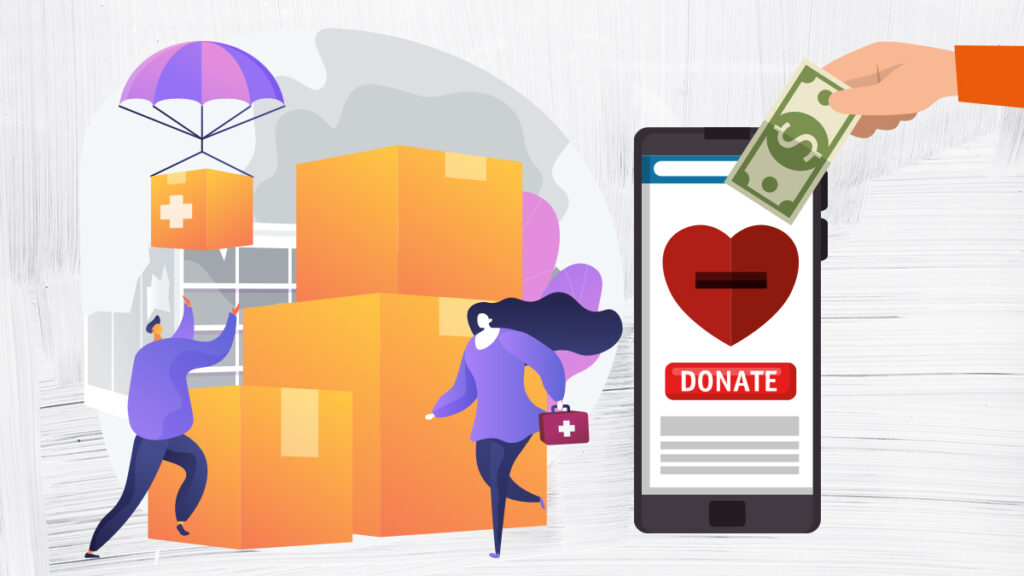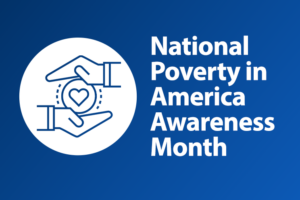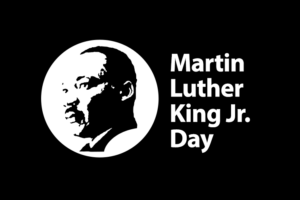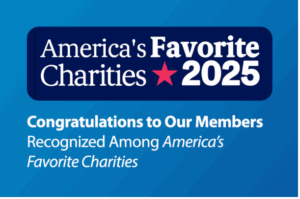Sarah Ford | March 16, 2022
Giving strategically after a disaster or crisis to support employees and the community
When a natural disaster or humanitarian crisis happens, naturally your company and its employees want to move swiftly to provide critical resources to the individuals and communities who need help. Perhaps an individual employee at your organization is experiencing personal financial hardship due to something like a house fire or a spouse being deployed for military duty, or maybe an entire business unit has been devastated by a hurricane or wildfire in their local community, or a global crisis develops like the COVID-19 pandemic or as we’ve seen more recently with the heart-breaking war in Ukraine. Your employees want a way to safely and easily help others, and your company wants to facilitate that giving – but how do you do that and where do you start?
Workplace giving programs, matching gift campaigns, corporate grants, volunteerism, employee assistance relief funds, and employee-directed giving are all great vehicles for supporting your employees and communities in times of crisis.
If you have been charged with getting a disaster relief campaign off the ground pronto and need a simple fundraising tool that can quickly be deployed within days, we can help you with that. According to the Conference Board Environmental, Social & Governance Center’s report, Disaster Philanthropy Practices 2021, the top priority of 73 percent of responding companies was immediate relief and short-term recovery. Only 22 percent of respondents from that same survey prioritized disaster preparedness and just 3 percent prioritized long-term recovery and reconstruction, yet the report’s authors note that “funding preparedness would actually reduce the need for relief and help build trust with communities, while funding long-term recovery and reconstruction would reduce the time it takes for communities to return to normal.”
While immediate humanitarian aid is important and certainly has its place, disaster giving tends to be reactive with the bulk of money donated going to immediate relief efforts. Ensuring long-term support is crucial to effectively helping affected communities rebuild and fully recover. That’s where sustainable, unrestricted funds from workplace giving programs and support from strategic partners play a tremendous role.
Efficient and effective disaster response and employee emergency relief calls for proactive, strategic planning. In addition to finding a giving platform that can support your team’s immediate disaster aid campaigns, we encourage you to take a more thoughtful approach to how your program can support-long-term disaster giving needs. America’s Charities can help you put the infrastructure in place for a more integrated program that automates and manages your disaster giving alongside your other types of giving and granting initiatives on one platform, and in addition to the out-of-the box reporting and dashboard capabilities we offer, we can also work closely with your team to configure custom reports and dashboards as well to help you monitor your impact and progress. Plus, by putting the proper infrastructure in place now, your team can more easily launch and “press go” for any future immediate disaster response campaigns and your employees will know they can go to that same giving platform each time a new disaster occurs (which helps make employee communications easier and more streamlined).
Regardless of whether you need a new disaster-giving platform ASAP or have time to put a more strategic program in place, there are some basic questions your team will need to answer.
Below is a shortlist to provide your team with some basic direction. To dig deeper into specific topics, we invite you to download the guides and toolkits available in our free resource library, and of course our team is happy to chat with you to discuss your needs further.
Who:
- Who will have access to participate in your program?
- Will all full-time and part-time employees be invited to participate or will some employees be excluded, such as contractors?
- Will your program focus on employees only or will you also invite external people to participate (e.g. board directors, partner companies, customers, family members of employees)?
- Your answer to “who” will participate will be closely connected to how you grant platform access (e.g. single sign-on (SSO) connection, login credentials based on unique identifiers, etc.).
- Who will manage your giving program? Do you have a dedicated team to handle things like employee donor questions, charity write-in requests, and program communications, or do you need outside support?
- If you plan to provide financial assistance to employees facing personal financial hardships through an EAF program, who will manage the application review process, maintain the funds, and handle reporting and compliance?
- If you’re focusing on a disaster relief campaign, who will be the recipient nonprofits and who will vet those organizations for you to ensure donations are going to a reputable charity?
What:
- What do you hope to achieve?
- Make sure you take time to speak with key decision-makers to ensure you choose a strategic partner and platform that offer the right tools to accomplish your goals. The things a procurement officer will focus on may differ significantly from the criteria your program manager has in mind. Taking a moment to obtain team input and consensus can help your team avoid some common pitfalls.
- Are you looking to facilitate donations in support of nonprofits, employees facing hardships, or a combination?
- What donation and giving methods do you want to offer?
- For immediate disaster response campaigns, credit/debit card giving tends to be most popular and efficient for getting donations to those impacted by a disaster. Charitable dollars, however, typically wane within the initial three to six months after a disaster, as media (and donor’s) attention moves on to other stories. A recurring payroll deduction donation can provide a disaster-related charity with much-needed sustainable resources to support long-term recovery and rebuilding efforts long after the funding from immediate relief runs dry. Perhaps your team would like to get out and volunteer or hold a drive to support a local community disaster. Not all giving platforms are setup to facilitate all types of giving and donation methods, so you’ll need to think about both your immediate and long-term program interests.
- Will your company match employee gifts? If so, what are the eligibility criteria and match ratios?
- What’s your budget for doing all of this?
- If you’re just starting out and need to make the case to leadership for more investment, it might make sense to start with a pilot program and expand your program with more of a phased approach. If you already offer a bunch of different giving methods (e.g. grants, volunteering, workplace giving), but have been using multiple platforms to manage everything, you might be able to save money and run your program more efficiently by consolidating to an all-in-one giving platform like America’s Charities Engage CSR Solution.
Where:
- Are your employees and other eligible contributors located in one city, several states throughout the U.S., or multiple countries worldwide? This question is particularly important to think about if your program involves volunteerism or local community donation drives.
- Where will contributions be directed? To 501c3 charities, employees, or both? Where are recipient charities and employees located?
- Disbursing charitable funds internationally is a completely different ballgame than what’s involved domestically within the United States. In addition to vetting nonprofits that are legitimate and will use donor funds responsibly (which is important for domestic or international giving), with international giving you need to consider the nuances of different currencies, tax laws, and even payroll systems (if you have multiple business units around the world).
When:
- How soon do you need to deploy your giving platform? Some donation methods and giving programs can be set up in days whereas others involve more legwork, so you’ll need to build in enough time for planning and setup depending on what your initiative entails.
- Will you keep the platform open year-round? If so, will some donation methods be available during finite campaign periods while other methods remain available all the time? For example, some employers offer employees a limited timeframe in which they can enroll in payroll deduction giving, while they allow employees to make credit card donations anytime throughout the year.
How:
- How will you measure success? Your team likely has some specific goals you want to accomplish through this program. Are there specific reports you will need or metrics you’ll want to closely monitor to track your progress towards meeting those goals?
- How personalized do you need the platform to be? Are you looking for a platform with basic branding and out-of-the-box content, or are you looking for something more configurable and personalized?
- How much staff time do you have to devote to administer the program? Some aspects of your program might make sense for your team to handle if you have the internal capacity, but there’s also an opportunity cost that must be considered. Every hour you spend on internal staff time costs your company money (as the company in this case study found), so it might be less costly to go outside for help.
Having an agile technology platform and trusted partner to disburse charitable funds efficiently and securely is of the utmost importance when it comes to disaster response and emergency assistance. Thinking through the questions above and working with an experienced partner like America’s Charities will help your company and its employees respond with greater speed, as well as ensure your impact is strategic and effective. In addition to benefiting from our more than 40 years of experience distributing charitable funds and managing these types of programs, you’ll get to work with a very passionate and knowledgeable team (40% of our staff have been working here for nearly a decade or longer) who can set you up for success from the very start and help grow your program for long-term collective impact across all of your CSR initiatives.

Get Resources and Insights Straight To Your Inbox
Explore More Articles
Congratulations to Our Members Recognized Among America’s Favorite Charities
Each year, The Chronicle of Philanthropy releases its list of America’s Favorite Charities—the 100 nonprofits that raise the most from individual donors, foundations, and corporate…
Read ArticleGet Resources and Insights Straight To Your Inbox
Receive our monthly/bi-monthly newsletter filled with information about causes, nonprofit impact, and topics important for corporate social responsibility and employee engagement professionals, including disaster response, workplace giving, matching gifts, employee assistance funds, volunteering, scholarship award program management, grantmaking, and other philanthropic initiatives.




